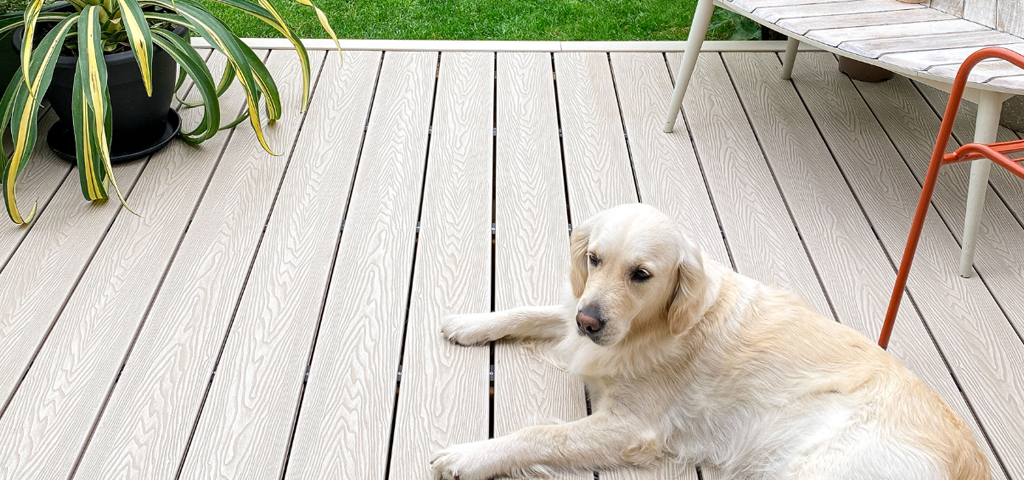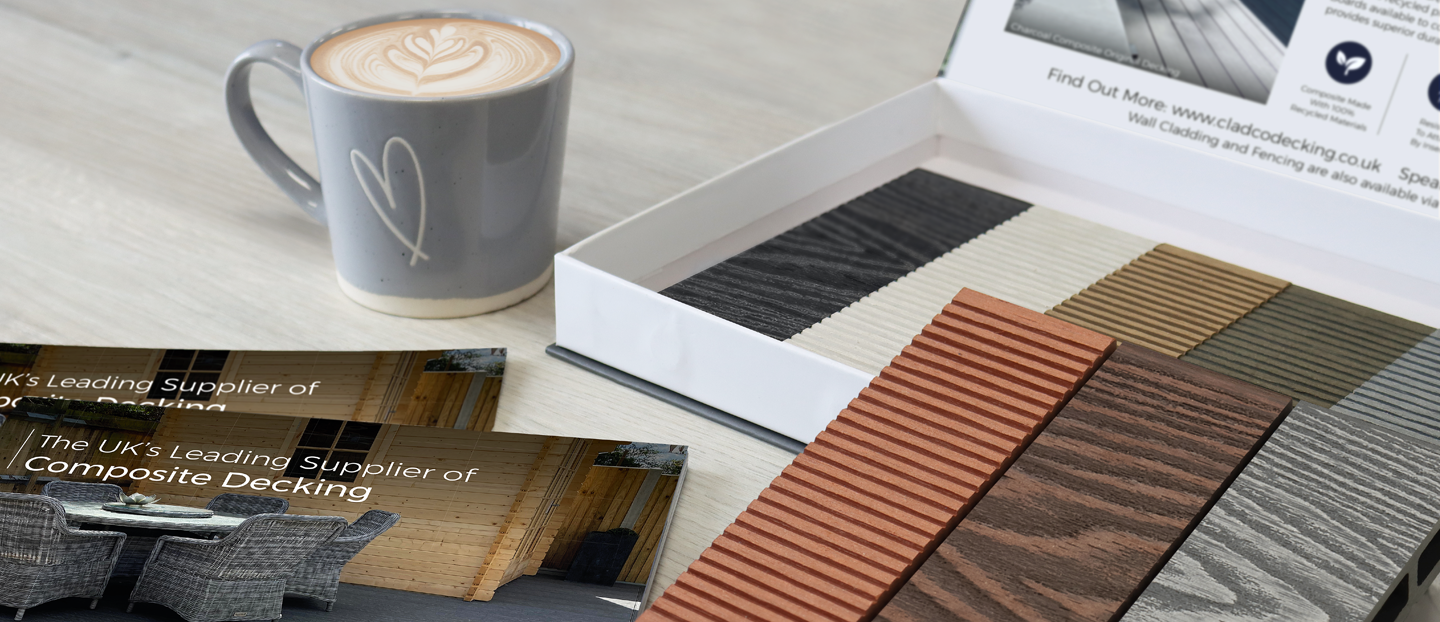When choosing a type of material for your garden decking, it is important to consider the environmental impact. Installing eco-friendly decking is a great step that you can take to make a substantial difference.
In this blog, we will discuss environmentally friendly options for decking and break down what makes certain options more favourable than others.


The importance of eco-friendly decking
Wood decking has always been a popular material, providing a natural and sturdy solution for deck boards. Many homeowners choose wooden decking to reflect the organic elements in their gardens and often steer clear of virgin plastic decking boards due to the perception of them being worse for the environment.
With a dramatic shift towards sustainable living, the need for more eco-friendly products is at an all-time high. There is now a larger variety of options that can cater to your individual sustainability needs.
Sustainability of timber decking
The manufacturing of traditional timber decking boards can produce a large carbon footprint, due to factors such as the production of lumber, deforestation, wood waste and the generally slow regrowth rate of trees.


The need to replace worn or weathered boards over time also reduces timber decking’s overall sustainability. Replacing decking boards within just a few years of purchase reduces their overall sustainability.
However, there are ways to reduce timber decking’s environmental impact. For example, Cladco timber decking boards are green pressure-treated for added durability and kiln-dried for improved stability and water resistance. Crucially, they’re made from responsibly sourced wood, giving you peace of mind when purchasing.
What is the most sustainable wood for decking?
Redwood is often considered one of the most sustainable decking options out there. It’s typically air-dried, reducing energy use during production, and has a fast regrowth rate, making it a more renewable choice overall.
Eco-friendly materials for decking
Composite decking boards are a popular eco-friendly choice, first introduced in the 1990s to address the limited lifespan and maintenance issues associated with traditional wood decking. Blending recycled wood and post-consumer plastics, composite is favoured by many homeowners for its durability, longevity and cost-effectiveness.
Wood-plastic composite decking is much lower maintenance compared to timber, with no need for time consuming staining, sealing or regular power washing. One of the advantages of Cladco composite decking boards is that they're made from recycled materials, making them a great choice for those eager to install eco-decking to enhance their outdoor space. Our Signature and ProDeck composite decking boards are designed with a reversible surface, featuring a wood grain texture and narrow grooves to suit your decking preferences. Made from part-recycled plastic, these eco-friendly composite decking boards are lightweight and easy to install.


Recycled plastic decking is a relative newcomer to the world of outdoor decking. Made entirely from recycled plastic waste, including food packaging and plastic bottles, these boards help prevent tonnes of waste from ending up in landfill. Built to withstand extreme weather, moisture, UV exposure, mould and insect attack, these boards have an impressive lifespan. Our own recycled plastic decking, for example, can last several decades, far longer than traditional timber decking.


They’re also one of the lowest-maintenance decking materials available, needing no regular cleaning, staining or treating. Once installed, a simple occasional wash is all that’s required. This is a key reason why recycled plastic decking is so popular in public and high-traffic spaces.
Bamboo is another durable eco-decking option for those who want to incorporate natural wood into their decking design. Like redwood, bamboo is highly renewable due to its rapid replanting and regrowth rate, with a manufacturing process that minimises carbon emissions.
Bamboo decking boards are typically manufactured under high pressure and temperature, creating a dense and durable product. One factor to consider is where the bamboo comes from. While the material itself is sustainable, many species are native to Asia, meaning the finished product often travels thousands of miles, adding to its overall carbon footprint.


Eco credentials of Cladco composite decking
Cladco composite decking boards comprise a mix of recycled hardwood fibres and polyethylene. The combination of reclaimed wood fibre and recycled plastic makes for a dependable decking material that offers the appearance of natural wood while being low-maintenance and environmentally conscious.
Our ProDeck composite decking boards also feature a polymer-capped shell for added strength, durability, and resistance to stains and mould. This extra layer helps extend the life of your decking and reduces the need for replacement, lowering its overall carbon footprint.


Also, our composite products are available as FSC® Certified for the same cost. If a product is FSC® Certified, it means that all materials used come from responsibly managed FSC® Certified forests. If you require FSC® Certified products, please ask for these when placing your order.


It's not just the surface of your deck where environmentally-friendly decisions can be made. The subframe can also be constructed using recycled plastic joists and posts. Made from 100% recycled plastic, these joists allow you to build an entirely eco-friendly foundation for a fully sustainable decking structure.


Recycling and re-using composite decking
Although wood-plastic composite decking is made from recycled wood fibres and plastic, recycling the boards themselves isn’t a quick or simple process. Because the materials are fused together with bonding agents, separating them for reuse requires specialist facilities and a lot of energy.
Some local recycling centres may accept composite decking, but this remains rare across most of the UK. Always check with your local facility before preparing to drop off your boards. Most councils provide details on local recycling centres and the materials they accept. You can enter your postcode on the gov.uk website to find your local authority and recycling information.


Alternatively, you could hire a professional disposal service, or if your decking is still in good condition, sell or reuse the boards. Upcycling leftover materials is one way to extend their life. You can repurpose the material to create steps, skirting, benches or planter boxes, to name a few.
Did you know you can also give back to the wildlife in your garden using your composite decking off-cuts? These guides can help you transform your recycled composite decking boards into an insect house or a bird house.
FAQs
How much does eco-friendly decking cost?
There is a wide range of sustainable and environmentally-friendly decking materials to choose between, from recycled plastic decking to wood composite decking.
Timber is by far the most affordable decking option, costing around £15 per m². Composite decking offers greater durability for a higher price, around £38 per m² for Signature and £49 per m² for ProDeck.
Recycled plastic decking sits at the top end of the price scale at roughly £73 per m², but offers exceptional longevity and zero maintenance once installed.
While prices vary, recycled plastic decking offers by far the longest lifespan. Once installed, it’s unlikely you’ll ever need to replace it, making it a smart, long-term investment.
Timber’s low upfront cost can be appealing, but its shorter lifespan and ongoing maintenance costs often make it more expensive in the long run. Even with regular care, it will usually need replacing much sooner than composite or recycled plastic decking.
Is composite decking really eco-friendly?
Although it's difficult to create a product that is entirely eco-friendly or sustainable, Cladco composite decking boards are made from recycled wood fibres and recycled plastic. This makes composite decking a genuinely eco-friendly option compared with traditional timber. Using recycled wood fibres reduces the need for tree felling, while the recycled plastic content helps divert waste from landfill, making it a more sustainable choice overall.
Conclusion
To summarise, there are plenty of ways to reduce your environmental impact, and choosing eco-decking products is one of them. Whether your preference is timber, recycled plastic or composite boards, environmentally friendly decking can be simple to understand and install.
Ready to start your eco-friendly decking journey? Explore our range of decking materials online or give our Sales Team a call at 01837 659901 to take the next steps.
Last Updated: October 23, 2025
Please note all information is correct at the time of writing. However, we encourage you to do your own research to ensure it remains accurate and relevant to your needs.



